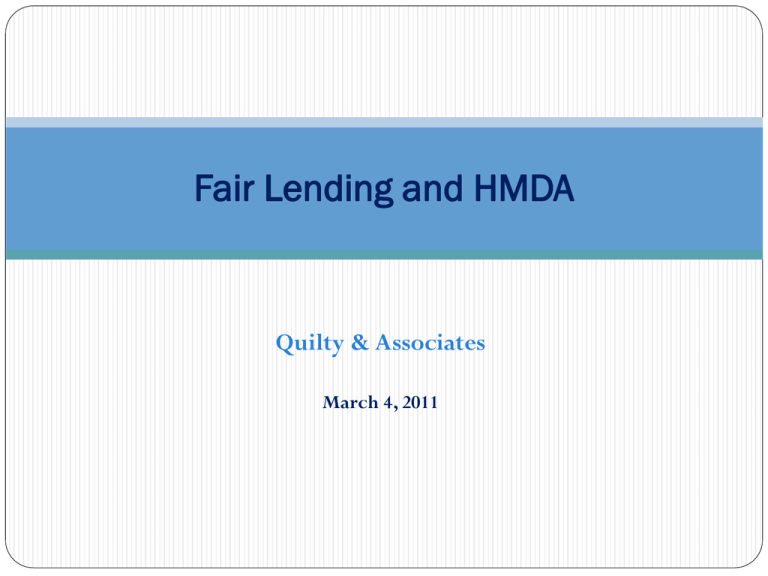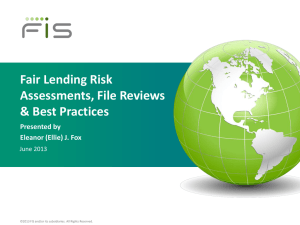
Fair Lending and HMDA
Quilty & Associates
March 4, 2011
Agenda
Fair Lending Overview
HMDA Data Integrity
Changes on the Horizon
Quilty & Associates 03/04/2011
Fair Lending Overview
Fair Lending Regulatory Framework
Types of Lending Discrimination
Federal Financial Institutions Examination Council
(“FFIEC”) Fair Lending Examination Guidelines
Quilty & Associates 03/04/2011
Fair Lending Regulatory Framework
Equal Credit Opportunity Act (ECOA) and
Regulation B
Fair Housing Act (FH Act)
Home Mortgage Disclosure Act (HMDA) and
Regulation C
Quilty & Associates 03/04/2011
Fair Lending Regulatory Framework
Equal Credit Opportunity Act (ECOA) and Regulation B
Purpose is to promote the availability of credit to all creditworthy applicants
without regard to:
Race
Color
Religion
National origin
Sex
Marital status
Age
The fact that all or part of the applicant's income derives from a public assistance
program
The fact that the applicant has in good faith exercised any right under the
Consumer Credit Protection Act.
Quilty & Associates 03/04/2011
Fair Lending Regulatory Framework
Equal Credit Opportunity Act (ECOA) and Regulation B
The regulation prohibits creditor practices that discriminate on
the basis of any of these factors.
The regulation also requires creditors to notify applicants of
action taken on their applications;
To retain records of credit applications;
Quilty & Associates 03/04/2011
Fair Lending Regulatory Framework
Equal Credit Opportunity Act (ECOA) and Regulation B
To collect Government Monitoring Information (“GMI”):
information about the applicant's race and other personal
characteristics in applications for certain dwelling-related loans;
For applicants to indicate whether they intend to apply for joint
credit;
And to provide applicants with copies of appraisal reports used in
connection with credit transactions.
Quilty & Associates 03/04/2011
Fair Lending Regulatory Framework
Fair Housing Act (FH Act)
Prohibits housing discrimination on the basis of race, color,
religion, sex, disability, familial status, and national origin.
It is unlawful to discriminate in any aspect of selling or renting
housing or to deny a dwelling to a buyer or renter because of
the disability of that individual, an individual associated with the
buyer or renter, or an individual who intends to live in the
residence.
Quilty & Associates 03/04/2011
Fair Lending Regulatory Framework
Home Mortgage Disclosure Act (HMDA) and Regulation C
To provide the public with information that will help show
whether financial institutions are serving the housing credit
needs of the neighborhoods and communities in which they are
located;
Financial institutions and lenders are required to submit a report
annually which includes 26 data fields for every reportable loan
Data is used during Fair Lending examinations to identify
discriminatory lending patterns.
Quilty & Associates 03/04/2011
Types of Lending Discrimination
Overt evidence of disparate treatment
Comparative evidence of disparate treatment
Evidence of disparate impact
Quilty & Associates 03/04/2011
Types of Lending Discrimination
Overt Evidence of Disparate Treatment
The lender openly discriminates on a prohibited basis.
For example, refusing to grant credit to applicants over 65.
Quilty & Associates 03/04/2011
Types of Lending Discrimination
Comparative Evidence of Disparate Treatment
The lender treats an applicant differently based on one of the
prohibited bases.
It does not require any showing that the treatment was
motivated by prejudice or a conscious intention to discriminate
beyond the difference in treatment itself.
It is considered to be discrimination by courts to be intentional
discrimination because no credible, non-discriminatory reason
explains the difference in treatment of a prohibited basis.
Quilty & Associates 03/04/2011
Types of Lending Discrimination
Comparative Evidence of Disparate Treatment (cont.)
Example: A non-minority couple applies for a loan. They have
adverse information on their credit report, and the lender
assists them in correcting inaccurate information in the report
in order to get the loan. A minority couple in the same
situation is denied for the loan based on the negative credit
report without giving the couple an opportunity to discuss the
report.
Quilty & Associates 03/04/2011
Types of Lending Discrimination
Evidence of Disparate Impact
When a lender applies a practice equally to all applicants, but the
policy or practice disproportionately excludes or burdens certain
persons on a prohibited basis, the policy or practice is described as
having a “disparate impact”.
When an Agency finds that a lender’s policy or practice has a
disparate impact, the next step is to determine whether the policy or
practice is justified by “business necessity”. This business necessity
may not be hypothetical or speculative. Cost or profitability could be
relevant factors.
Example: A lender does not extend loans for less than $60,000. This
minimum loan amount policy disproportionately excludes potential
minority applicants from consideration because of their income levels
or the value of the houses in the areas in which they live.
Quilty & Associates 03/04/2011
FFIEC Fair Lending Examination Guidelines
A Fair Lending MUST READ
Guidelines can be found at:
www.ffiec.gov/pdf/fairlendpdf
Perfect Senior Management Fair Lending training
tool
Quilty & Associates 03/04/2011
Fair Lending Examination Guidelines
Table of Contents
Part I: Examination Scope Guidelines
Step One – Develop an Overview
Step Two - Identify Compliance Program Discrimination Risk
Factors
Step Three - Review Residential Loan Products
Step Four - Identify Residential Lending Discrimination Risk Factors
Step Five - Organize and Focus Residential Risk Analysis
Step Six - Identify Consumer Lending Discrimination Risk Factors
Step Seven – Identify Commercial Lending Discrimination Risk
Factors
Step Eight - Complete the Scoping Process
Quilty & Associates 03/04/2011
Fair Lending Examination Guidelines
Table of Contents
PART II - COMPLIANCE MANAGEMENT REVIEW
PART III - EXAMINATION PROCEDURES
A. Verify Accuracy of Data
B. Documenting Overt Evidence of Disparate Treatment
C. Transactional Underwriting Analysis - Residential and Consumer Loans
D. Analyzing Potential Disparities in Pricing and Other Terms and Conditions
E. Steering Analysis
F. Transactional Underwriting Analysis - Commercial Loans
G. Analysis of Potential Discriminatory “Redlining”
H. Analysis of Potential Discriminatory Marketing Practices
I. Credit Scoring
J. Disparate Impact Issues
Quilty & Associates 03/04/2011
Fair Lending Examination Guidelines
Table of Contents
PART IV - OBTAINING AND EVALUATING RESPONSES FROM
THE INSTITUTION AND CONCLUDING THE EXAMINATION
APPENDIX
I. Compliance Management Analysis Checklist
II. Considering Automated Underwriting and Credit Scoring
III. Evaluating Responses to Evidence of Disparate Treatment
IV. Fair Lending Sample Size Tables
V. Identifying Marginal Transactions
VI. Potential Scoping Information
VII. Special Analyses
VIII. Using Self-Tests and Self-Evaluations to Streamline the Examination
Quilty & Associates 03/04/2011
HMDA
Why the “Compliance Report Card”?
HMDA data collection requirements from application through
post-closing
HMDA data integrity trends point to weaknesses in compliance
overall
Quarterly review of LAR: perfect opportunity to monitor
performance
Quilty & Associates 03/04/2011
Overview
1. HMDA Survival Steps
2. Common Error Trends
Quilty & Associates 03/04/2011
HMDA Survival Steps
Step 1: Identify an employee who will be responsible for
overall HMDA quality
Must have an understanding of residential compliance requirements
Loan Officers and Operations staff should share HMDA responsibilities
An officer of the institution must monitor HMDA reporting throughout the
year, and must certify to its accuracy at year-end.
Quilty & Associates 03/04/2011
HMDA Survival Steps
Step 2: Write HMDA policy and procedures
Provide detailed guidance for each of the 26 data fields on the
Loan Application Register (“LAR”)
Procedures should reflect LOS functionality
Consider using a HMDA checklist in each file
Should be a custom “HMDA Guide to Getting It Right” for your
institution
Quilty & Associates 03/04/2011
HMDA Survival Steps
Step 3: Identify the HMDA reportable loans
HMDA Reportable Loans:
Purchase, home improvement or refinancing of a loan secured by a
“dwelling”
HELOCs are optional
Commercial loans may be reportable
Unsecured home improvement loans may be reportable
Pre-Approvals may be reportable
Quilty & Associates 03/04/2011
HMDA Survival Steps
Step 3: Identify the HMDA reportable loans
HMDA Reportable Loans:
Investor/Broker Rule
Broker Definition: An institution that takes and processes an application and arranges
for another institution to acquire the loan at or after closing.
Investor Definition: An institution that acquires a loan from a broker at or after
closing.
Quilty & Associates 03/04/2011
HMDA Survival Steps
Step 3: Identify the HMDA reportable loans
HMDA Reportable Loans:
If a broker sends an application to an investor for underwriting prior to closing,
the investor reports the loan.
If a broker does not send the application to the investor for underwriting prior
to closing, the broker reports the loan.
Quilty & Associates 03/04/2011
HMDA Survival Steps
Step 3: Identify the HMDA reportable loans
Not HMDA Reportable:
Land loans
Temporary financing
Pre-qualifications
Loans where credit decision was made by another
institution
Refer to HMDA Guide to Getting It Right for a complete list
Quilty & Associates 03/04/2011
HMDA Survival Steps
Step 3: Identify the HMDA reportable loans
Run Loan Production reports off the LOS for the calendar year for all
HMDA reportable products
Run reports for all types of action taken
Include Loans In Process in your scope
Is the Pipeline Management up to date?
Has ECOA notification been provided?
Quilty & Associates 03/04/2011
HMDA Survival Steps
Step 4: Review HMDA reportable loans for data
integrity
Choose random sample of loans to test
Review larger sample of denied/withdrawn loans
Compare loan file to the actual LAR or HMDA export file for each of the 26
data fields
Retain audit work papers to document the file review
Expand scope if significant error rate is identified
Quilty & Associates 03/04/2011
HMDA Survival Steps
Step 5: React to the error trends!
Analyze the error trends: find the source of the problem
SHARE THE INFORMATION!
Strengthen Internal Controls
TRAIN, TRAIN, TRAIN!!
Revise HMDA procedures if necessary
Quilty & Associates 03/04/2011
HMDA Survival Steps
Step 6: Don’t Forget HMDA Disclosure Requirements
• HMDA Poster must be displayed
in the lobby of home office
and each branch office
• Display in a prominent location
Quilty & Associates 03/04/2011
HMDA Survival Steps
Step 6: Don’t Forget HMDA Disclosure Requirements
Modified LAR must be made available to the public within 30 days for
requests made after March 1
Must delete application number, application received date and action taken
date to protect member privacy
Modified LAR must be available for 3 years
Train your staff (branch managers, CSRs)
Quilty & Associates 03/04/2011
HMDA Survival Steps
Step 6: Don’t Forget HMDA Disclosure Requirements
FFIEC posts reports @
www.ffiec.gov by institution,
which comprises an
institution’s “Disclosure
Statement”
Disclosure statement
must be made available
to the public within 3 days of
posting to the internet
Must be available for 5 years
Quilty & Associates 03/04/2011
Common HMDA Error Trends
Error Trend: Action Taken Type is Wrong
High error rate!!
HMDA Codes not consistent with industry lingo
Code 1: Loan Originated
Code 2: Approved Not Accepted
Code 3: Denied
Code 4: Applicant Expressly Withdrew
Code 5: File Closed for Incompleteness
Code 6: Loan Purchased by Your Institution
Code 7: Preapproval Request Denied
Code 8: Preapproval Request Approved but not accepted (optional
reporting)
Quilty & Associates 03/04/2011
Error Trend: Action Taken Type is Wrong
Solution: React with ECOA Training and Controls
Notification requirements within 30 days of a receiving a completed application:
1.
Applicant expressly withdraws
2.
Loan is Incomplete
3.
4.
CAUTION: File must be documented
Do not use this action taken for applicants who do not proceed with the GFE unless the
applicant expressly withdrew
Must send “Regulation B Compliant” Notice of Incomplete Application
Loan is Denied
Loan is Approved
Quilty & Associates 03/04/2011
Common HMDA Error Trends
Error Trend: Loan Amount is Wrong for Denied/Withdrawn
Loans
Unexplained loan amount changes
1/1/2010 RESPA Changes
Counteroffer loans
May result in different action taken type
Quilty & Associates 03/04/2011
Common HMDA Error Trends
Error Trend: Application Received Date is Not Supported In
the File
Is the date consistent with other application documents?
Where there’s smoke, there’s fire.
Consistent problems with documenting application received date may point to
general lack of understanding
Is it time for training: When does an inquiry become an application?
Be consistent by application channel: internet, face to face, etc.
Review procedures for each loan product
Quilty & Associates 03/04/2011
Common HMDA Error Trends
Error Trend: Loan Purpose
Pecking order: Purchase, then home improvement, then refinance
Multiple purpose loans
Insufficient detail in file for cash out
Review purpose codes: any home improvement?
Quilty & Associates 03/04/2011
Common HMDA Error Trends
Error Trend: Government Monitoring Information (“GMI”)
If the application is taken face to face, the applicant completes the GMI box.
If they indicate “I do not wish to furnish”, you must complete the ethnicity, race and sex by
visual observation AND note “By visual observation” on the application!
Quilty & Associates 03/04/2011
Common HMDA Error Trends
Error Trend: Government Monitoring Information (“GMI”)
If the application is taken by mail or on-line, the applicant fills out the GMI section. The
information should not be altered or edited by the loan officer.
If the application is taken by phone, the loan officer must read the text in the GMI section and
note what the applicant provides. The information should not be altered or edited by the loan
officer.
Quilty & Associates 03/04/2011
Common HMDA Error Trends
Error Trend: Identifying reportable loans: Investor/Broker
Not the same meaning in the industry
Institution making the credit decision reports the loan
If a Broker sends the file to an Investor for underwriting prior to closing, the
Investor reports that loan, not the Broker – whether the loan closes or not.
Reporting tied to credit decision, not to source of funds
Quilty & Associates 03/04/2011
HMDA Changes on the Horizon
Dodd-Frank Act includes change to the data collected and reported under HMDA.
Additional fields to be reported are:
Applicant’s age
Total points and fees
Prepayment penalty term
Collateral value
Teaser period
Non-fully amortizing payment feature
Loan term
Origination channel
Property parcel number
Applicant credit scores
SAFE Act originator ID
Universal loan identifier
APR for loan and benchmark test
Quilty & Associates 03/04/2011
HMDA Changes on the Horizon
• Dodd Frank clearly intends to intensify the focus on Fair
Lending.
• All oversight activities will be consolidated within one
division of the newly created Bureau for Consumer
Financial Protection, and the Bureau will have additional
data under HMDA to support its analyses.
• The availability of new data under HMDA and increase in
regulatory scrutiny will necessitate a refreshed
assessment of fair lending compliance programs.
Quilty & Associates 03/04/2011
Questions?
Quilty & Associates 03/04/2011









